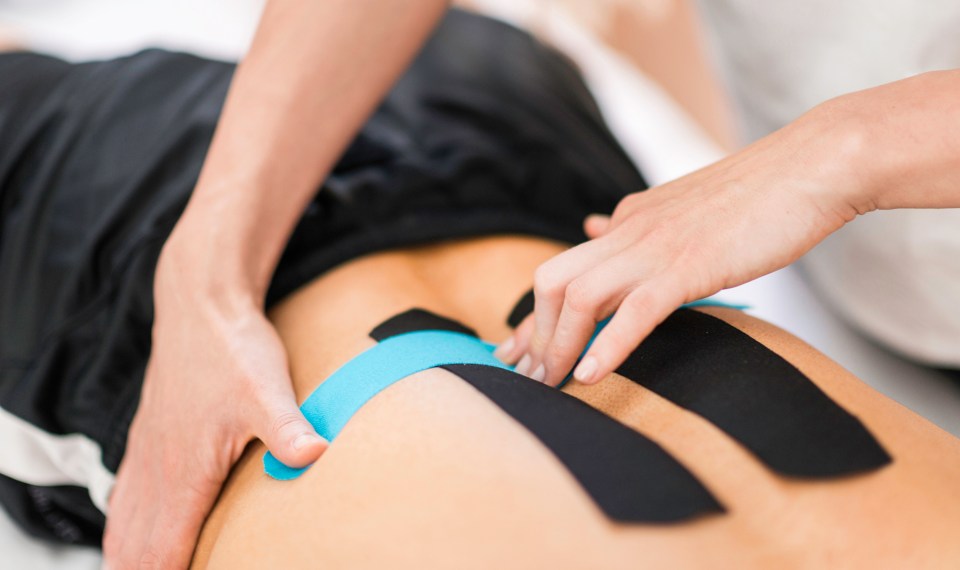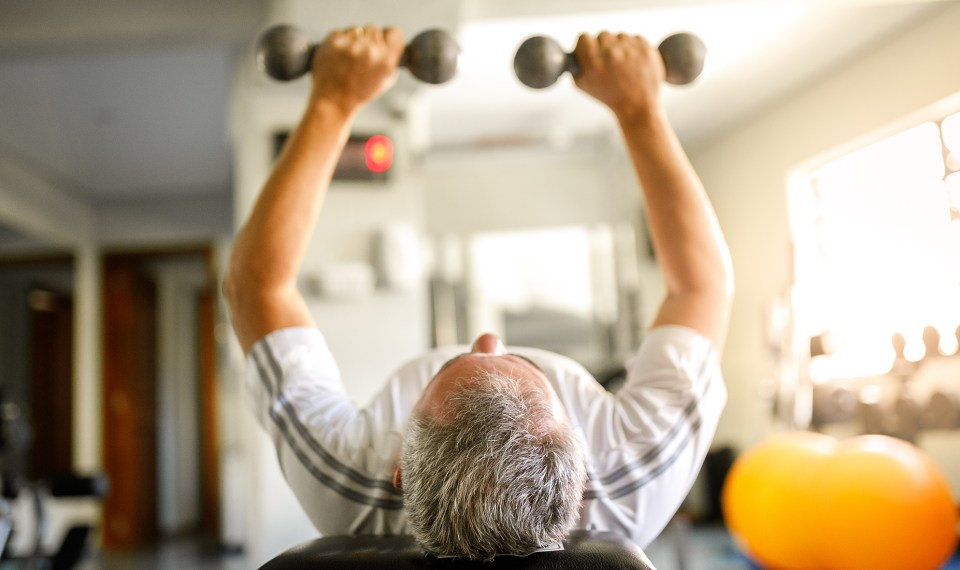You’ve likely seen it on professional athletes. The patterns of tape stretched across parts of their bodies is known as kinesio taping therapy. Though it was originally created to help athletic performance after an injury, you don’t have to be a professional athlete or even an amateur one to reap its benefits.
Ashley Harris, staff occupational therapist at Encompass Health Rehabilitation Hospital of Greenville in South Carolina, said she frequently uses kineso taping techniques with her patients, who are typically older adults recovering from conditions such as stroke and hip fracture.
“Whenever I approach a patient about using taping therapy, I tell them it’s that funky tape you see on athlete’s knees at the Olympics; we’re just going to use it a little differently than they do,” she said. “Kinesiology tape can be used for a multitude of things.”
What Is Kinesio Taping Therapy?
Kinesio tape, also known as K-tape or physical therapy tape, is a type of thin, flexible tape that has varying levels of elasticity. Depending on the level of stretch applied, kinseio taping therapy can help support joints and muscles, decrease swelling and pain and improve joint performance.
The stretch of the tape can go anywhere from zero to 100%. The higher the percentage of stretch, the more support the K-tape provides.
“Typically, the tighter the stretch, the deeper down you’re supporting,” Harris said. “When you’re at 75 to 100% stretch, it’s more for muscular support. When it’s at zero to 25%, it’s supporting the skin and lymphatic system to reduce swelling.”
In addition to the amount of stretch, the kinesio tape is also placed in specific patterns, depending on the desired outcome and body part. It can stay on for up to four days, but typically not longer than five. The tape is water-resistant, but after repeated washing and over time, the stickiness does wear off.
How Does It Reduce Pain and Swelling?
The lymphatic system sits directly under the skin and impacts circulation. When kinesio tape is applied, it pulls the skin away from the lymphatic system, thus reducing pressure and improving circulation. This helps decrease swelling and pain. It also increases healing to the impacted bones and muscles.
“It really opens those channels up to allow the blood to flow, decreasing swelling to make the person more comfortable,” Harris said.
Who Can Benefit from Kinesio Therapy?
Just about anyone can benefit from kinesio taping therapy—active or not. Harris said it’s appropriate for all ages. There are special types of K-tape for children and older adults with thinner, more fragile skin. For those individuals, Harris advises always having someone who is trained in kinesio taping therapy to assist in applying and removing the tape properly.
“There is a brand for pediatrics, and it also works for older adults,” she said. “I would never encourage my patients to pull off the tape themselves. You need someone who is trained in pulling it off. Family can be educated on application and removal. The tape can leave blisters if not done correctly.”
About the only people kinesio taping is not appropriate for, Harris added, are those who have allergies to adhesives.
What Conditions can Taping Therapy Treat?
Kinesio taping can help with a variety of conditions from pregnancy to recovering from surgery and stroke. It’s designed mainly to improve swelling and reduce pain. The tape can be used on just about any part of the body. The most common parts of the body that K-tape are applied to include:
- Back
- Calves
- Hamstrings
- Wrists and hands
- Shoulders
- Knees
Harris said the tape ican be used to relieve back pain. You do this by applying it in an H-shaped pattern on the back, she added. In addition to treating inflammation and pain, it can also help with movement, which is why she sometimes uses the technique with those recovering from stroke.
“I am certified in stroke rehabilitation, and spent a whole afternoon (at a conference) learning different taping techniques,” she said. “Basically with stroke, the arm may have very little or no motion on the affected side of where the stroke occurred. The tape provides a sensation and feeling of support, depending on the tape pattern. “
K-tape can be applied to the affected part of the body to give them more awareness of the limb. “It doesn’t heal it, but it helps provide a stable support system so the arm just doesn’t drop and dangle,” Harris added.
Does Kinesio Therapy Really Work?
Kinesio taping therapy is not a cure, but it can help increase the speed of healing and decrease swelling and pain short-term. Harris said she’s experienced this with her patients, as well as herself.
“I messed up my ankle a couple of years ago,” she recalled. “It was very swollen. I had a PT put kinesio tape on, and it was better five days later. The swelling and bruising were gone.”
The content of this site is for informational purposes only and should not be taken as professional medical advice. Always seek the advice of your physician or other qualified healthcare provider with any questions you may have regarding any medical conditions or treatments.



